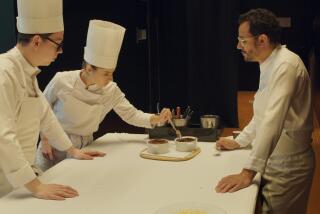the Dordogne : Few European...
- Share via
SIORAC-EN-PERIGORD, France — One cannot, goes the caveat of regional biographer laureate Freda White, judge countries by their capitals.
So may terminal jet lag (to say nothing of woe) betide the traveler who sees New York as all the United States has to offer and considers London the sole merriment of merrie olde England or remembers Paris as toute la boutique.
By all means visit these masterpiece metropolises. Especially Paris. But then bow out and away, instructs White, “as a courtier bows himself out of the presence of an old, indifferent queen. He will then straighten his back and go away and look at ordinary places and talk to ordinary people.”
And ordinary France, for centuries, has been snoozing peacefully among three southwestern rivers that dawdle through a placid region of quiet villages where keeping busy means doing nothing in particular except deciding what might not get done demain , tomorrow.
The French escape their cities to vacation alongside these rivers, the Lot, Dordogne and Tarn. Non-European tourists remain rarities because they’re still exploring Paris, Deauville, Cannes, Biarritz and other stops packaged by Catatonic Tours. And with Paris (more than 300 miles northeast) the closest non-stop arrival point by air from the United States, this area remains secluded to all but travelers by car and train--and cyclists armed with a definite destination and a working knowledge of celestial navigation.
Advises a local hotel flyer aimed at incoming Europeans: “The nearest airport is Bordeaux, 100 miles . . . main line trains from Paris stop at Le Buisson, 5 miles.”
Geographically, we’re east of coastal Bordeaux (as in wine) and south of Limoges (as in porcelain) and north of the Pyrenees (as in: “Bienvenido a Espana ... pasaporte, por favor” ).
On the far right is mountainous Languedoc and the Cevennes, the hard-stone heights of the Central Massif cupping limestone plateaus that sprawl into the widening valleys of the Aquitaine Basin to the far left.
Wriggling this width are the three rivers and their tributaries; a network forming a region that as an expression of national personality and native origins is to France what a meld of New England, the Midwest and Upstate New York would be to the United States.
Few European areas are richer in history . . . Neanderthal and Cro-Magnon man bivouacked here, Richard the Lion-Hearted was killed here, the Hundred Years’ War (1337-1453) ended here, and French resistance to occupation during World War II by Nazi Germany and the Vichy government began here.
Few French regions have such a visible past . . . troglodyte cliff dwellings, grottoes and painted caves; more 12th-Century castles than Encino has condos; and, tragically, too many roadside crosses and marble markers in passionate and quite unforgiving commemoration of local partisans executed by the Gestapo.
This corner of France, its hidden hamlets, its riverside villages with some cut into cliffs and clinging there, may also comprise a rare and hallowed holdout against the multiple malignancies of modern commerce . . . with no apparent encroachment to date by Hilton or Hertz, McDonald’s or Colonel Sanders.
It gets better.
The climate is temperate and reliable. In a classic of zero growth, tiny, mossy communities (such as Monpazier) have not expanded beyond their original fortified walls since the 12th Century. The Who’s Who of the area includes David, son of the late British Field Marshall Montgomery, who owns a summer home, and Scott, son of Charles Lindbergh, who operates a simian research center at St. Chamassy.
And until her death in 1975, legendary Folies Bergere star and St. Louis-born singer Josephine Baker owned the 15th-Century Chateau des Milandes near Castelnaud--home for her large foster family of international orphans.
Local industries are cottage, traditional, yet a huge contribution to the international religion of French food. Oak and hazel trees yield one pricey underground fungus . . . truffles. Dank woods of chestnuts and oaks produce another . . . cepes, a brown, spongy, quite delicious mushroom.
(As an aside, the Perigord region is world headquarters of the delicate black truffle. Last year, locally, they sold for $90 a pound. In a New York speciality shop the going price was $30. Per ounce.)
Fields of broadleaf tobacco bushes feed the French habit for harsh, black, bronchial Gauloise cigarettes.
Grain for the Geese
Great stands of corn tell of another regional passion. They provide the rich grain forced into fat geese whose bloated livers (still with us?) become the original, genuine, world-class goose liver pate. Attention, mes eleves, my students. Beware of pate (pate) de (of) foie (liver) gras (fat) imitations formed from other poultry livers. Examine the label for vital mentions of oie (goose) liver as the essential ingredient composing the unadulterated pate that (with a sliver of truffle for oomph) is the pride of Perigord.
These, however, are facts and stats, data and dates, the required guidebook stuff of the area. The Dordogne (at least this immediate area around Siorac-en Perigord . . . the Middle Dordogne, also known as the Black Perigord within the diocese of Sarlat) holds a higher essence of grand delights.
A pristine, unpolluted light here produces intense, quite unclouded colors. A painter’s paradise. The countryside was mute, even eerie, until a listener on a hill only two miles from the secondary highway into Siorac recognized an incredible truth. There were no man-made sounds, no noise from any internal combustion engine, not even a lawn mower to crack the silence that was here when the world began.
Fishing, Hiking, Picnics
Everything is perfect for something. Broad, still rivers for easy trout fishing. Meadows for hiking, wildflowers and picnics of crusty bread, white wine and, of course, oie liver pate. Roofed and cobbled marketplaces bubbling with haggling over crates of those cepes. Villages and chateaux so medieval, so pristine, that visitors don’t simply touch the past . . . they are accepted by it.
“It is unspoiled beauty, the colors, the warm yellow stones and the green meadows,” says Liz Boorn. “So rich, so pure, warm roofs, hot tiles.”
Boorn is an expatriate Australian from Melbourne. She came here 10 years ago with a Dutch husband who had promised to help a friend’s home renovation project. The project expanded into a business and the visit became permanent residence.
They live in the village of Berbiguieres (where dinners at Auberge du Montand are of local cuisine, family-prepared and cost not much more than a fast-food lunch in Burbank) and operate a four-machine automatic laundry (Monsieur Bubbles) that is the newest thing in Siroac. By several centuries.
Unhurried and Happy
Boorn and husband Steven Peters (that agreement on names and separate identities is likely the first touch of marital ecumenism to hit medieval Dordogne) are unhurried, happy and in agreement on this area of France that is their hideaway.
They are not overly delighted with the emergence (barely a rumor by American standards) of gift, pottery and pate de foie gras shops in picturesque places such as Sarlat (commandeered last year by filming of “The Bride,” a Frankenstein remake starring Sting, Jennifer Beals, and Liz Boorn in a bit part), Domme and Souillac.
Yet neither pace nor populations, they say, should change drastically anytime in the next eight centuries. As a matter of fact, says Liz, the tourist boom may have come and gone.
“There was a time about five years ago when there was a noticeable increase in tourists to this area,” she explained. “But it seemed like they looked, went away and decided not to come back.”
Heavy in Beauty
From disappointment? Hardly. It’s just that the area is heavy in beauty, history and cultivation. It most definitely is not for kids into video games and windsurfing. Nor for adults tuned to casinos, theaters, discos and Galleries Lafayette.
I came in all innocence, shoved by the insistence of an English sister and brother-in-law. Go find The Real France, they ordered. But I know every clifftop curve of the Corniche, raw wines of the Camargue, mussels in cream at Deauville, the little hotels of Paris, the lace makers of Reims . . . the real France. That, they countered, is your France and not The Real France.
So we drove in from Limoges, south on N20 for 100 kilometers and through Brive. That’s when driving became more of a grope. Back roads to small towns and lanes leading to villages. Detours that never disappointed. Bottle-green hills rising then sliding aside to reveal a river and a chateau and villages leaning contentedly.
Brigadoon. Goshen. Land of Prester John. The ease of yesterday with fun promises for tomorrow. And as enchantment grew, travel slowed, allowing time and space to examine. . . . OK, sis, The Real France.
The Hotel Scholly
In Siroac is the Hotel Scholly that has been an insider’s recommendation since the ‘40s. Georges Scholly, owner and revered chef de cuisine , is gone now. But a daughter, Nicole, is running the office, and her husband, Raymond Pouget, is commanding the kitchen. Scholly would be quite satisfied.
Accommodations are beamed and cozy. Service is discreet and from the Houdini school of appearance and disappearance. The food is regional, exceptional, with an exquisite specialty of feather-sliced sweetbreads and cepes (sauteed by local custom in walnut oil) served on puff pastry. And for morning walks when partners sleep in, there’s always Pasha, the hotel’s gentle, giant German shepherd who is welcome in every Bar-Tabac in town.
Hotel Scholly is three-star. In France these days, with the dollar stronger than 1952 Calvados, that means $25 a night. With bath. For two. Including breakfast.
Siroac, however, is only one gem in the cluster.
And that returns us to Freda White and her “Three Rivers of France,” a recommended guide for the area.
“The Dordogne is a romantic river,” she wrote. “The Lot is a magical river. The Tarn is a breathtaking river. Oh, happy traveler, you have the choice of three.”
More to Read
Sign up for The Wild
We’ll help you find the best places to hike, bike and run, as well as the perfect silent spots for meditation and yoga.
You may occasionally receive promotional content from the Los Angeles Times.






